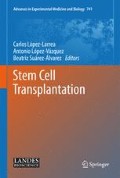Abstract
Gene therapy aims to transfer genetic material into cells to provide them with new functions. A gene transfer agent has to be safe, capable of expressing the desired gene for a sustained period of time in a sufficiently large population of cells to produce a biological effect. Identifying a gene transfer tool that meets all of these criteria has proven to be a difficult objective. Viral and nonviral vectors, in vivo, ex vivo and in situ strategies co-exist at present, although ex vivo lenti- or retroviral vectors are presently the most popular.
Natural stem cells (from embryonic, hematopoietic, mesenchymal, or adult tissues) or induced progenitor stem (iPS) cells can be modified by gene therapy for use in regenerative medicine. Among them, hematopoietic stem cells have shown clear clinical benefit, but iPS cells hold humongous potential with no ethical concerns.
Access this chapter
Tax calculation will be finalised at checkout
Purchases are for personal use only
Preview
Unable to display preview. Download preview PDF.
References
Jopling C, Boue S, Izpisua Belmonted JC. Dedifferentiation, transdifferentiation and reprogramming: three routes to regeneration. Nat Rev Mol Cell Biol. 2011 Feb;12(2):79–89.
Noguchi P. Risks and benefits of gene therapy. N Engl J Med 2003; 348:193–194.
Urnov FD, Miller JC, Lee YL et al. Highly efficient endogenous human gene correction using designed zinc-finger nucleases. Nature 2005; 435:646–651.
Chan PP, Glazer PM. Triplex DNA: Fundamentals, advances, and potential applications for gene therapy. J Mol Med 1997; 75:267–282.
Berns A. Good news for gene therapy. N Engl J Med 2004; 350(16):1679–1680.
Gene therapy progress and prospects. Special tissue. Gene Ther 2004; 11.
Räty JK, Lesch HP, Wirth T et al. Improving safety of gene therapy. Curr Drug Saf 2008; 3(1):46–53.
Douglas KL. Toward development of artificial viruses for gene therapy: a comparative evaluation of viral and non-viral transfection. Biotechnol Prog 2008; 24:871–883.
Foldvari M, Babiuk S, Badea I. DNA delivery for vaccination and therapeutics through the skin. Curr Drug Deliv 2006; 3(1):17–28.
Acsadi G, Dickson G, Love DR et al. Human dystrophin expression in mdx mice after intramuscular injection of DNA constructs. Nature 1991; 29:757–758.
Ahrlund-Richter L, De Luca M, Marshak DR et al. Isolation and production of cells suitable for human therapy: challenges ahead. Cell Stem Cell 2009; 4:20–26.
Cuende N, Izeta A. Clinical translation of stem cell therapies: a bridgeable gap. Cell Stem Cell 2010; 6(6):508–512.
Alexander BL, Ali RR, Alton EW et al. Progress and prospects: gene therapy clinical trials (part 1). Gene Ther 2007; 14(20):1439–1447.
Gatti RA, Meuwissen HJ, Allen HD et al. Immunological reconstitution of sex-linked lymphopenic immunological deficiency. Lancet 1968; 2:1366–1369.
Unger C, Kärner E, Treschow A et al. Lentiviral-mediated HoxB4 expression in human embryonic stem cells initiates early hematopoiesis in a dose-dependent manner but does not promote myeloid differentiation. Stem Cells. 2008; 26:2455–2466.
Takahashi K, Tanabe K, Ohnuki M et al. Induction of pluripotent stem cells from adult human fibroblasts by defined factors. Cell 2007; 131:861–872.
Hadjantonakis A, Papaioannou V. The stem cells of early embryos. Differentiation 2001; 68:159–166.
Kucerova L, Altanerova V, Matuskova M et al. Adipose tissue-derived human mesenchymal stem cells mediated prodrug cancer gene therapy. Cancer Research. 2007; 67:6304–6313.
Pittenger MF, Mackay AM, Beck SC et al. Multilineage potential of adult human mesenchymal stem cells. Science 1999; 284(5411):143–147.
Kumar S, Chanda D, Ponnazhagan S. Therapeutic potential of genetically modified mesenchymal stem cells. Gene Ther 2008; 15(10):711–715.
Strom S, Fisher R. Hepatocyte transplantation: new possibilities for therapy. Gastroenterology 2003; 124:568–571.
Rideout WM 3rd, Hochedlinger K, Kyba M et al. Correction of a genetic defect by nuclear transplantation and combined cell and gene therapy. Cell 2002; 109:17–27.
Ott MG, Schmidt M, Schwarzwaelder K et al. Correction of X-linked chronic granulomatous disease by gene therapy, augmented by insertional activation of MDS1-EVI1, PRDM16 or SETBP1. Nat Med 2006; 12:401–409.
Podsakoff GM, Engel BC, Carbonaro DA et al. Selective survival of peripheral blood lymphocytes in children with HIV-1 following delivery of an anti-HIV gene to bone marrow CD34(+) cells. Mol Ther 2005; 12:77–86.
Weiss ML, Troyer DL. Stem cells in the umbilical cord. Stem Cell Rev 2006; 2:155–162. Review.
Le Blanc K, Rasmusson I, Sundberg B et al. Treatment of severe acute graft-versus-host disease with third party haploidentical mesenchymal stem cells. Lancet 2004; 363:1439–1441.
Studeny M, Marini FC, Dembinski JL et al. Mesenchymal stem cells: potential precursors for tumor stroma and targeted-delivery vehicles for anticancer agents. J Natl Cancer Inst 2004; 96:1593–1603.
Kumar S, Ponnazhagan S. Bone homing of mesenchymal stem cells by ectopic alpha 4 integrin expression. FASEB J 2007; 21:3917–3927.
Hachiya A, Sriwiriyanont P, Patel A et al. Gene transfer in human skin with different pseudotyped HIV-based vectors. Gene Ther 2007; 14:648–656.
Mavilio F, Pellegrini G, Ferrari S et al. Correction of junctional epidermolysis bullosa by transplantation of genetically modified epidermal stem cells. Nat Med 2006; 12:1397–1402.
Raya A, Rodriguez-Piza I, Guenechea G et al. Disease-corrected haematopoietic progenitors from Fanconi anaemia induced pluripotent stem cells. Nature 2009; 460:53–59.
Sun N, Longaker MT, Wu JC. Human iPS cell-based therapy. Considerations before clinical applications. Cell Cycle 2010; 9:880–885.
Author information
Authors and Affiliations
Corresponding author
Editor information
Editors and Affiliations
Rights and permissions
Copyright information
© 2012 Landes Bioscience and Springer Science+Business Media
About this chapter
Cite this chapter
Muñoz Ruiz, M., Regueiro, J.R. (2012). New Tools in Regenerative Medicine: Gene Therapy. In: López-Larrea, C., López-Vázquez, A., Suárez-Álvarez, B. (eds) Stem Cell Transplantation. Advances in Experimental Medicine and Biology, vol 741. Springer, New York, NY. https://doi.org/10.1007/978-1-4614-2098-9_17
Download citation
DOI: https://doi.org/10.1007/978-1-4614-2098-9_17
Publisher Name: Springer, New York, NY
Print ISBN: 978-1-4614-2097-2
Online ISBN: 978-1-4614-2098-9
eBook Packages: Biomedical and Life SciencesBiomedical and Life Sciences (R0)

